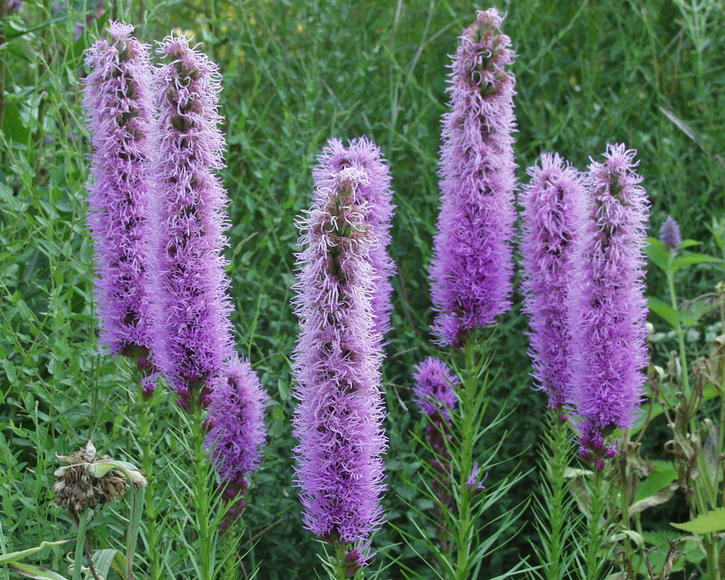Blazing star, Gayfeather
The unusual inflorescences of the Blazing star magically draw attention in flower beds. The frugal shrub is also a real butterfly magnet.
Factsheet
- Growth type
-
- Perennial plant
- rhizome
- Growth height (from)
- from 30 cm to 80 cm
- Growth width (from)
- from 30 cm to 50 cm
- Growth characteristics
-
- upright
- horst-forming
- Flower color
-
- purple
- pink
- Flowering time (month)
-
- July to September
- Flower shape
-
- Spike
- Flowercups
- Leaf color
-
- green
- page format
-
- grassy
- linear
- narrow lanceolate
- Light
-
- sunny to scattered light
- Soil type
-
- sandy to loamy
- Soil Moisture
-
- fresh to humid
- ph value
-
- alkaline to weakly acidic
- Lime compatibility
-
- lime-loving
- Nutrient requirements
-
- nutrient-rich
- Humus
-
- rich in humus
- Decorative or utility value
-
- Flower Decoration
- Nectar or pollen plant
- Toxicity
-
- non-toxic
- Winter Hardness
-
- hardy
- Use
-
- Flowerbeds
- Bouquets
- Group planting
- Planters
- Garden style
-
- Flower garden
- patio
- Prairie Garden
- Pot garden
- Water garden
Liatris is native to North America. The genus is counted in the daisy (Asteraceae) family and includes around 40 species. Its natural habitat is in marshes, along path edges and water embankments in low to hilly countryside.
Liatris grows in clumps between 16 to 35 inches tall. If forms a basal leaf crown and grows straight upright, generally with unbranched, leafy stalks. It overwinters underground in a tuberous, thickened rhizome.
The narrow, lanceolate, green leaves are arranged alternately along the stalk. In the lower section of the stalk, lots of leaves form a basal, grass like crown.
The roughly 7.87 inch long, spike like flower clusters appear from July to September and consist of numerous small flower heads. These are pinkish-red, purple-pink or white, depending on the variety. The special thing about the Blazing star: Unlike most other plants with elongated inflorescences, it flowers from top to bottom. The countless flower heads take a few days to open.

The Blazing star is a real sun worshipper, which is why the shrub should be planted in as warm and sunny a place as possible in the garden. The loose, nutrient and humus rich soil should not be too acidic, fresh to moist and if possible, should not be left to dry out for too long a period. The shrub is also intolerant to waterlogging - it is particularly susceptible to winter dampness. You should therefore take care to ensure good drainage.
The Blazing star is completely frost-hardy in permeable soils. Plant it in loamy soils and ensure there is plenty of sand and gravel in order to guarantee good drainage. If you add some compost when planting in the spring it will live longer in lean, sandy soils. It’s a good idea to rejuvenate the shrubs by dividing them every five years in the spring.
After flowering, the spikes should be cut off above the leaves in order to prevent seed formation. They should then be fully cut back in late fall or early spring. Ideally, you should cut the stalks and leaves of the shrub to 1.97 inches above the soil.

However, the Blazing star also looks fantastic in prairie gardens. You can also combine it with decorative grasses such as switchgrass (Panicum virgatum), echinacea, various phlox species and Helenium varieties. The dwarf variety ‘Kobold’ is also popular as a container decoration on terraces.
Blazing star, like many Echinacea, is also prized as a long-lasting cut flower. When the flowers are half opened on the spike, they can be cut and used in a bouquet. Blazing stars tied in a bouquet create beautiful dried flowers - for this, wait to cut them until all of the flowers have opened. Then hang the flowers upside down in a well ventilated place to dry.
The variety ‘Kobold’ is a dwarf Blazing star and flowers violet-pink. Its 16 inch growth height makes it suitable for the front of flower beds. The Blazing star ‘Floristan white’ flowering in white, similarly to ‘Alba’, has long stretching inflorescences and reach a height of 32 inches. The variety ‘Floristan violet’ has lilac colored flowers.
Blazing star can be sown in pots or boxes in the fall. However, it is much easier to propagate by dividing the bulb in the spring. Dig up the root stock and divide it into the individual, tuberous segments; these can then be replanted in the flower bed. This vegetative propagation method can also be used to propagate the garden types in such a way as to remain faithful to their varieties.
Blazing star is not popular with snails however, voles like to munch on the bulbs. Blazing star rarely develops diseases - occasionally it suffers from powdery mildew, rust and leaf spots, however, these are not life-threatening.


